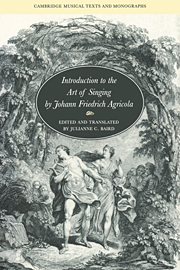Book contents
- Frontmatter
- Contents
- Acknowledgments
- Introduction: Agricola's treatise
- INTRODUCTION TO THE ART OF SINGING
- Translator's preface
- Foreword of the author
- Introduction of the author
- 1 Observations for the use of the singing teacher
- 2 Concerning appoggiaturas
- 3 Concerning trills
- 4 Concerning divisions
- 5 Concerning recitative
- 6 Remarks intended especially for the music student
- 7 Concerning arias
- 8 Concerning cadenzas
- 9 Remarks for the use of the professional singer
- 10 Concerning improvised variations of melodies
- Notes
- Bibliography
- Index
10 - Concerning improvised variations of melodies
Published online by Cambridge University Press: 10 December 2009
- Frontmatter
- Contents
- Acknowledgments
- Introduction: Agricola's treatise
- INTRODUCTION TO THE ART OF SINGING
- Translator's preface
- Foreword of the author
- Introduction of the author
- 1 Observations for the use of the singing teacher
- 2 Concerning appoggiaturas
- 3 Concerning trills
- 4 Concerning divisions
- 5 Concerning recitative
- 6 Remarks intended especially for the music student
- 7 Concerning arias
- 8 Concerning cadenzas
- 9 Remarks for the use of the professional singer
- 10 Concerning improvised variations of melodies
- Notes
- Bibliography
- Index
Summary
1. Since the so-called improvised variations (a) are the most beautiful that a singer can conceive of introducing and the most pleasant that the connoisseur can hear, it is necessary that a singer should consider very seriously how he may learn the art of skillfully inventing them.
(a) An improvised ornamentation, or variation, is called by the Italians, un passo.
2. He must know that there are five essential qualities that when combined with each other, yield a marvelous perfection. These are knowledge of harmony, invention, observance of the rhythm, judgment, and taste.
3. There are also five non-essential embellishments, which are always available to further ornament the improvised variations. These are: the appoggiatura, the various essential graces, the portamento of the voice, the slur, and the drag.
The essential qualities teach:
4. That no changes may occur but through the application of a thorough knowledge of harmony.
5. That a fortuitous power of invention should present rare and special thoughts, but at the same time beautiful ones, in that it avoids the familiar and the ordinary.
6. That these variations, since they are ruled by the strict but sound [lit., worthy] rules of rhythm, can never leave the ordered boundaries thereof without losing their own integrity.
7. That the improvised ornaments, as introduced with the finest discernment, are placed only in an appropriate location above the bass. Here they cavort playfully and provide unexpected pleasure.
- Type
- Chapter
- Information
- Introduction to the Art of Singing by Johann Friedrich Agricola , pp. 232 - 238Publisher: Cambridge University PressPrint publication year: 1995



